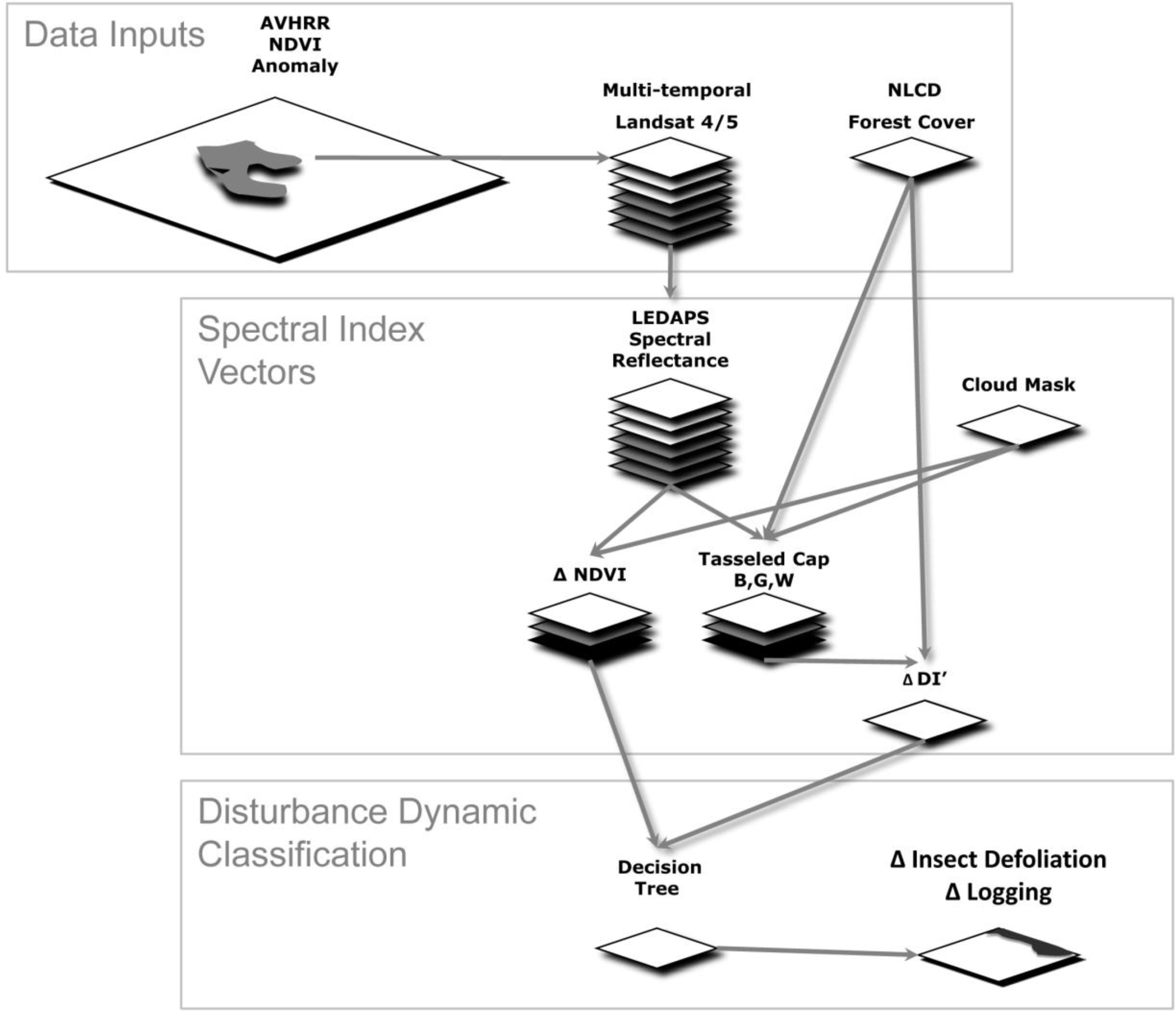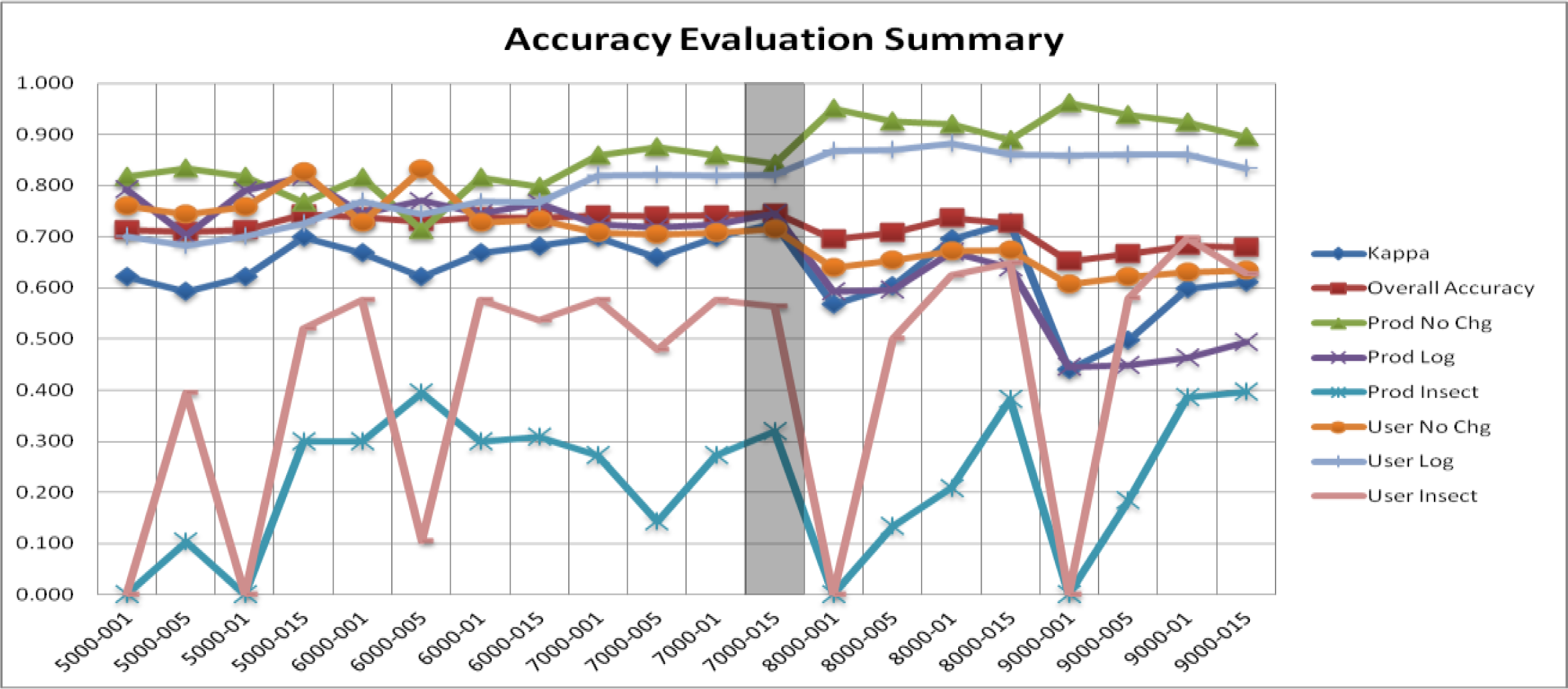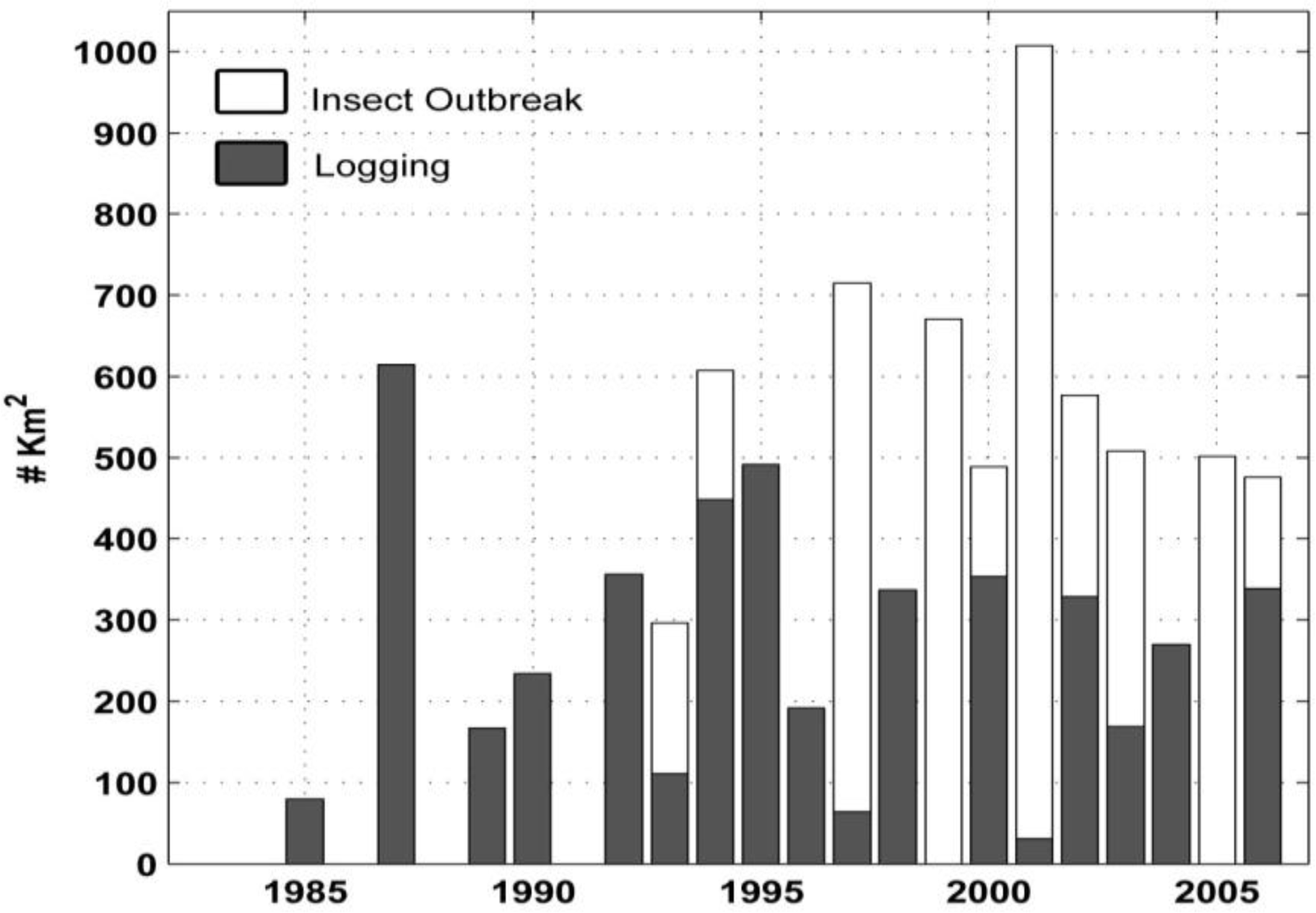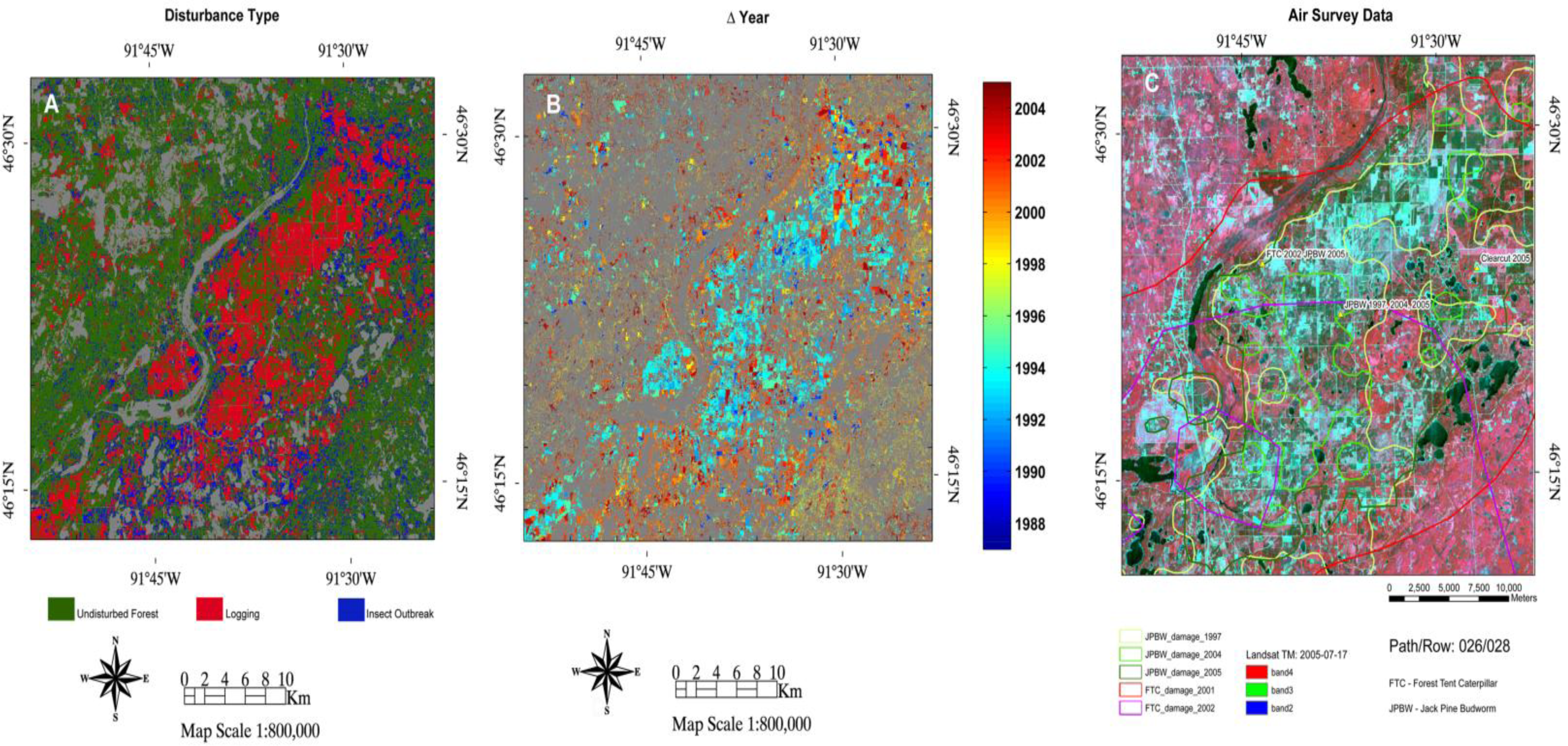An Automated Approach to Map the History of Forest Disturbance from Insect Mortality and Harvest with Landsat Time-Series Data
Abstract
:1. Introduction
2. Data and Methods
2.1. Study Area
2.2. Landsat Data
2.2.1. Landsat Forest Mask
2.2.2. Landsat Cloud Masking
2.2.3. Landsat Disturbance Classification
2.2.4. Running Landsat Classifications
2.2.5. Independent Classification Evaluation Data
2.2.6. Ancillary Data
2.2.7. Landsat Classification Evaluation Procedure
Automated Classification Evaluation
Manual Classification Evaluation and Statistical Analysis
3. Results
3.1. Drivers of AVHRR NDVI Declines
3.2. Trends in Insect Air Surveys
3.3. Landsat Disturbance Classification
4. Discussion
5. Conclusions
Acknowledgments
Author Contributions
Conflicts of Interest
References
- Gower, S.T. Patterns and mechanisms of the forest carbon cycle. Ann. Rev. Environ. Res 2003, 28, 169–204. [Google Scholar]
- Houghton, R.A.; Hackler, J.L.; Lawrence, K.T. The U.S. carbon budget: Contributions from land-use change. Science 1999, 285, 574–578. [Google Scholar]
- Pacala, S.W.; Hurtt, G.C.; Baker, D.; Peylin, P.; Houghton, R.A.; Birdsey, R.A.; Heath, L.; Sundquist, E.T.; Stallard, R.F.; Ciais, P.; et al. Consistent land- and atmosphere-based U.S. carbon sink estimates. Science 2001, 292, 2316–2320. [Google Scholar]
- Pan, Y.D.; Birdsey, R.A.; Fang, J.Y.; Houghton, R.; Kauppi, P.E.; Kurz, W.A.; Phillips, O.L.; Shvidenko, A.; Lewis, S.L.; Canadell, J.G.; et al. A large and persistent carbon sink in the world’s forests. Science 2011, 333, 988–993. [Google Scholar]
- Canadell, J.G.; Pataki, D.; Gifford, R.; Houghton, R.A.; Lou, Y.; Raupach, M.R.; Smith, P.; Steffen, W. Saturation of the Terrestrial Carbon Sink. In Terrestrial Ecosystems in a Changing World; Canadell, J.G., Pataki, D., Pitelka, L., Eds.; Springer-Verlag: Berlin, Germany, 2007; pp. 59–78. [Google Scholar]
- Plugge, D.; Kohl, M. Estimating carbon emissions from forest degradation: Implications of uncertainties and area sizes for a REDD+ MRV system. Can. J. For. Res 2012, 42, 1996–2010. [Google Scholar]
- Sasaki, N.; Chheng, K.; Ty, S. Managing production forests for timber production and carbon emission reductions under the REDD plus scheme. Environ. Sci. Policy 2012, 23, 35–44. [Google Scholar]
- Tucker, C.J.; Pinzon, J.E.; Brown, M.E.; Slayback, D.A.; Pak, E.W.; Mahoney, R.; Vermote, E.F.; Saleous, N.E. An Extended AVHRR 8-km NDVI Data Set Compatible with MODIS and SPOT Vegetation NDVI Data. Int. J. Remote Sens 2005, 26, 4485–4498. [Google Scholar]
- Tucker, C.J. Red and photographic infrared linear combinations for monitoring vegetation. Remote Sens. Environ 1979, 8, 127–150. [Google Scholar]
- Gamon, J.A.; Field, C.B.; Goulden, M.L.; Griffin, K.L.; Hartley, A.E.; Joel, G.; Penuelas, J.; Valentini, R. Relationships between NDVI, canopy structure, and photosynthesis in 3 Californian vegetation types. Ecol. Appl 1995, 5, 28–41. [Google Scholar]
- Goetz, S.J.; Bunn, A.G.; Fiske, G.J.; Houghton, R.A. Satellite-observed photosynthetic trends across boreal North America associated with climate and fire disturbance. Proc. Natl. Acad. Sci. USA 2005, 102, 13521–13525. [Google Scholar]
- Goetz, S.J.; Fiske, G.J.; Bunn, A.G. Using satellite time-series data sets to analyze fire disturbance and forest recovery across Canada. Remote Sens. Environ 2006, 101, 352–365. [Google Scholar]
- Goetz, S.J.; Mack, M.C.; Gurney, K.R.; Randerson, J.T.; Houghton, R. Ecosystem responses to recent climate change and fire disturbance at northern high latitudes: Observations and model results contrasting northern Eurasia and North America. Environ. Res. Lett 2007, 2. [Google Scholar] [CrossRef]
- Bunn, A.G.; Goetz, S.J. Trends in satellite-observed circumpolar photosynthetic activity from 1982 to 2003: The influence of seasonality, cover type, and vegetation density. Earth Interact 2006, 10, 1–19. [Google Scholar]
- Bunn, A.G.; Goetz, S.J.; Fiske, G.J. Observed and predicted responses of plant growth to climate across Canada. Geophys. Res. Lett 2005, 32. [Google Scholar] [CrossRef]
- Bunn, A.G.; Goetz, S.J.; Kimball, J.; Zhang, K. Northern high-latitude ecosystems respond to climate change. EOS Trans. AGU 2007, 88, 333–340. [Google Scholar]
- Townshend, J.R.G. Remote Sensing-Global Local Views. In Horizons in Phys. Geography; Gregory, K., Gurnell, A., Eds.; MacMillian Publishers: London, UK, 1988. [Google Scholar]
- Townshend, J.R.; Masek, J.G.; Huang, C.Q.; Vermote, E.F.; Gao, F.; Channan, S.; Sexton, J.O.; Feng, M.; Narasimhan, R.; Kim, D.; et al. Global characterization and monitoring of forest cover using Landsat data: opportunities and challenges. Int. J. Digit. Earth 2012, 5, 373–397. [Google Scholar]
- Miller, J.D.; Thode, A.E. Quantifying burn severity in a heterogenous landscape with a relative version of the delta Normalized Burn Ratio (dNBR). Remote Sens. Environ 2007, 109, 66–80. [Google Scholar]
- Schroeder, T.A.; Wulder, M.A.; Healey, S.P.; Moisen, G.G. Mapping wildfire and clearcut harvest disturbances in boreal forests with Landsat time series data. Remote Sens. Environ 2011, 115, 1421–1433. [Google Scholar]
- Goodwin, N.R.; Coops, N.C.; Wulder, M.A.; Gillanders, S.; Schroeder, T.A.; Nelson, T. Estimation of insect infestation dynamics using a temporal sequence of Landsat data. Remote Sens. Environ 2008, 112, 3680–3689. [Google Scholar]
- Kurz, W.A.; Apps, M.J. Developing Canada’s national forest carbon monitoring, accounting and reporting systems to meet the reporting requirements of the Kyoto Protocol. Mitig. Adapt. Strat. Glob 2006, 11, 33–43. [Google Scholar]
- Tucker, C.J.; Grant, D.M.; Dykstra, J.D. NASA’s global orthorectified Landsat data set. Photogramm. Eng. Remote Sens 2004, 70, 313–322. [Google Scholar]
- Neigh, C.S.R.; Tucker, C.J.; Townshend, J.R.G. North American vegetation dynamics observed with multi-resolution satellite data. Remote Sens. Environ 2008, 112, 1749–1772. [Google Scholar]
- Masek, J.G.; Huang, C.Q.; Wolfe, R.; Cohen, W.; Hall, F.; Kutler, J.; Nelson, P. North American forest disturbance mapped from a decadal Landsat record. Remote Sens. Environ 2008, 112, 2914–2926. [Google Scholar]
- Goward, S.N.; Masek, J.G.; Cohen, W.; Moisen, G.; Collatz, G.J.; Healey, S.; Houghton, R.; Huang, C.; Kennedy, R.; Law, B.; et al. Forest disturbance and North American carbon flux. EOS Trans. AGU 2008, 89, 105–116. [Google Scholar]
- Kennedy, R.E.; Cohen, W.B.; Schroeder, T.A. Trajectory-based change detection for automated characterization of forest disturbance dynamics. Remote Sens. Environ 2007, 110, 370–386. [Google Scholar]
- Schroeder, T.A.; Wulder, M.A.; Healey, S.P.; Moisen, G.G. Detecting post-fire salvage logging from Landsat change maps and national fire survey data. Remote Sens. Environ 2012, 122, 166–174. [Google Scholar]
- Huang, C.Q.; Coward, S.N.; Masek, J.G.; Thomas, N.; Zhu, Z.L.; Vogelmann, J.E. An automated approach for reconstructing recent forest disturbance history using dense Landsat time series stacks. Remote Sens. Environ 2010, 114, 183–198. [Google Scholar]
- Coops, N.; Wulder, M.A. Estimating the reduction in gross primary production due to mountain pine beetle infestation using satellite observations. Int. J. Remote Sens 2010, 31, 2129–2138. [Google Scholar]
- Miller, J.D.; Knapp, E.E.; Key, C.H.; Skinner, C.N.; Isbell, C.J.; Creasy, R.M.; Sherlock, J.W. Calibration and validation of the relative differenced Normalized Burn Ratio (RdNBR) to three measures of fire severity in the Sierra Nevada and Klamath Mountains, California, USA. Remote Sens. Environ 2009, 113, 645–656. [Google Scholar]
- Munyati, C.; Kabanda, T.A. Using multitemporal Landsat TM imagery to establish land use pressure induced trends in forest and woodland cover in sections of the Soutpansberg Mountains of Venda region, Limpopo Province, South Africa. Reg. Environ. Chang 2009, 9, 41–56. [Google Scholar]
- Pax-Lenney, M.; Woodcock, C.E.; Macomber, S.A.; Gopal, S.; Song, C. Forest mapping with a generalized classifier and Landsat TM data. Remote Sens. Environ 2001, 77, 241–250. [Google Scholar]
- Song, C.; Schroeder, T.A.; Cohen, W.B. Predicting temperate conifer forest successional stage distributions with multitemporal Landsat Thematic Mapper imagery. Remote Sens. Environ 2007, 106, 228–237. [Google Scholar]
- Soverel, N.O.; Perrakis, D.D.B.; Coops, N.C. Estimating burn severity from Landsat dNBR and RdNBR indices across western Canada. Remote Sens. Environ 2010, 114, 1896–1909. [Google Scholar]
- Radeloff, V.C.; Mladenoff, D.J.; Boyce, M.S. Detecting jack pine budworm defoliation using spectral mixture analysis: Separating effects from determinants. Remote Sens. Environ 1999, 69, 156–169. [Google Scholar]
- Stinson, G.; Kurz, W.A.; Smyth, C.E.; Neilson, E.T.; Dymond, C.C.; Metsaranta, J.M.; Boisvenue, C.; Rampley, G.J.; Li, Q.; White, T.M.; et al. An inventory-based analysis of Canada’s managed forest carbon dynamics, 1990 to 2008. Glob. Chang. Biol 2011, 17, 2227–2244. [Google Scholar]
- Kurz, W.A.; Dymond, C.C.; Stinson, G.; Rampley, G.J.; Neilson, E.T.; Carroll, A.L.; Ebata, T.; Safranyik, L. Mountain pine beetle and forest carbon feedback to climate change. Nature 2008, 452, 987–990. [Google Scholar]
- Hais, M.; Jonasova, M.; Langhammer, J.; Kucera, T. Comparison of two types of forest disturance using multitemporal Landsat TM/ETM+ imagery and field vegetation data. Remote Sens. Environ 2009, 113, 835–845. [Google Scholar]
- Stueve, K.M.; Housman, I.W.; Zimmerman, P.L.; Nelson, M.D.; Webb, J.B.; Perry, C.H.; Chastain, R.A.; Gormanson, D.D.; Huang, C.; Healey, S.P.; et al. Snow-covered Landsat time series stacks improve automated disturbance mapping accuracy in forested landscapes. Remote Sens. Environ 2011, 115, 3203–3219. [Google Scholar]
- Hais, M.; Kucera, T. Surface temperature change of spruce forest as a result of bark beetle attack: remote sensing and GIS approach. Eur. J. For. Res 2008, 127, 327–336. [Google Scholar]
- Radeloff, V.C.; Mladenoff, D.J.; Boyce, M.S. Effects of Interacting disturbances on landscape patterns: budworm defoliation and salavage logging. Ecol. Appl 2000, 10, 233–247. [Google Scholar]
- Grossmann, E.B.; Mladenoff, D.J. Open woodland and savanna decline in a mixed-disturbance landscape (1938 to 1998) in nthe Northwest Wisconsin (USA) Sand Plain. Landsc. Ecol 2007, 22, 43–55. [Google Scholar]
- Radeloff, V.C.; Mladenoff, D.J.; Boyce, M.S. The changing relation of landscape patterns and jack pine budworm populations during an outbreak. Oikos 2003, 90, 417–430. [Google Scholar]
- Reinikainen, M.; D’Amato, A.W.; Fraver, S. Repeated insect outbreaks promote multi-cohort aspen mixedwood forests in northern Minnesota, USA. For. Ecol. Manag 2012, 266, 148–159. [Google Scholar]
- Holben, B. Characteristics of maximum-value composite images from temporal AVHRR data. Int. J. Remote Sens 1986, 7, 1417–1434. [Google Scholar]
- Brown, M.E.; Pinzon, J.E.; Tucker, C.J. New vegetation index data set available to monitor global change. EOS Trans. AGU 2004, 85, 565–569. [Google Scholar]
- Pinzon, J.E.; Brown, M.E.; Tucker, C.J. EMD correction of orbital drift artifacts in satellite data stream. Interd. Math Sci 2005, 5, 167–186. [Google Scholar]
- Slayback, D.; Pinzon, J.; Los, S.; Tucker, C.J. Northern hemisphere photosynthetic trends 1982–99. Glob. Chang. Biol 2003, 9, 1–15. [Google Scholar]
- Eidenshink, J.; Schwind, B.; Brewer, K.; Zhu, Z.; Qualye, B.; Howard, S. A project for monitoring trends in burn severity. Fire Ecol 2007, 3, 3–21. [Google Scholar]
- USGS Global Visualization Viewer. Available online: http://glovis.usgs.gov (accessed on 17 March 2014).
- Crist, E.P.; Cicone, R.C. Application of the Tasseled Cap concept to simulated Thematic Mapper data. Photogramm. Eng. Remote Sens 1984, 50, 343–352. [Google Scholar]
- Guild, L.S.; Cohen, W.B.; Kauffman, J.B. Detection of deforestation and land conversion in Rondonia, Brazil using change detection techniques. Int. J. Remote Sens 2004, 25, 731–750. [Google Scholar]
- Healey, S.P.; Yang, Z.Q.; Cohen, W.B.; Pierce, D.J. Application of two regression-based methods to estimate the effects of partial harvest on forest structure using Landsat data. Remote Sens. Environ 2006, 101, 115–126. [Google Scholar]
- Homer, C.; Dewitz, J.; Fry, J.; Coan, M.; Hossain, N.; Larson, C.; Herold, N.; McKerrow, A.; VanDriel, J.N.; Wickham, J. Completion of the 2001 National Land Cover Database for the conterminous United States. Photogramm. Eng. Remote Sens 2007, 73, 337–341. [Google Scholar]
- Vieira, I.C.G.; de Almeida, A.S.; Davidson, E.A.; Stone, T.A.; de Carvalho, C.J.R.; Guerrero, J.B. Classifying successional forests using Landsat spectral properties and ecological characteristics in eastern Amazonia. Remote Sens. Environ 2003, 87, 470–481. [Google Scholar]
- Irish, R.R.; Barker, J.L.; Goward, S.N.; Arvidson, T. Characterization of the Landsat-7 ETM+ automated cloud-cover assessment (ACCA) algorithm. Photogramm. Eng. Remote Sens 2006, 72, 1179–1188. [Google Scholar]
- Masek, J.G.; Vermote, E.F.; Saleous, N.E.; Wolfe, R.; Hall, F.G.; Huemmrich, K.F.; Gao, F.; Kutler, J.; Lim, T. A Landsat Surface Reflectance Dataset for North America, 1990–2000. IEEE Geosci. Remote Sens 2006, 3, 68–72. [Google Scholar]
- Cohen, W.B.; Spies, T.A.; Alig, R.J.; Oetter, D.R.; Maiersperger, T.K.; Fiorella, M. Characterizing 23 years (1972–95) of stand replacement disturbance in western Oregon forests with Landsat imagery. Ecosystems 2002, 5, 122–137. [Google Scholar]
- Hilker, T.; Wulder, M.A.; Coops, N.C.; Linke, J.; McDermid, G.; Masek, J.G.; Gao, F.; White, J.C. A new data fusion model for high spatial- and temporal-resolution mapping of forest disturbance based on Landsat and MODIS. Remote Sens. Environ 2009, 113, 1613–1627. [Google Scholar]
- Townshend, J.R.G.; Justice, C.O.; Gurney, C.; McManus, J. The Impact of Misregistration on Change Detection. IEEE Trans. Geosci. Remote Sens 1992, 30, 1054–1060. [Google Scholar]
- WisconsinView. Available online: ftp://ftp.ssec.wisc.edu/pub/wisconsinview (accessed on 17 March 2014).
- USGS Monitoring Trends in Burn Severity (MTBS). Available online: www.mtbs.gov (accessed on 17 March 2014).
- Epting, J.; Verbyla, D.; Sorbel, B. Evaluation of remotely sensed indices for assessing burn severity in interior Alaska using Landsat TM and ETM+. Remote Sens. Environ 2005, 96, 328–339. [Google Scholar]
- United States Department of Agriculture. Forest Insect and Disease Conditions in the United States, 2008; USDA: Washington, DC, USA, 2009; p. 37. [Google Scholar]
- Klien, W.H.; Tunnock, S.; Ward, J.G.D.; Knopf, J.A.E. Aerial Sketchmapping; USDA: Fort Collins, CO, USA, 1983; p. 15. [Google Scholar]
- McConnell, T.; Johnson, E.; Burns, B. A Guide to Conducting Aerial Sketchmap Surveys; USDA: Fort Collins, CO, USA, 2000; p. 88. [Google Scholar]
- Biging, G.; Congalton, R.G. Advances in Forest Inventory Using Advanced Digital Imagery. In Proceedings of Global Natural Research Monitoring and Assessments: Preparing for the 21st Century, Venice, Italy, 24–30 September 1989; pp. 1241–1249.
- Congalton, R.G. A review of assessing the accuracy of classifications of remotely sensed data. Remote Sens. Environ 1991, 37, 35–46. [Google Scholar]
- Lu, D.; Weng, Q. A survey of image classification methods and techniques for improving classification performance. Int. J. of Remote Sens 2007, 28, 823–870. [Google Scholar]
- Muller, S.V.; Walker, D.A.; Nelson, F.E.; Auerbach, N.A.; Bockheim, J.G.; Guyer, S.; Sherba, D. Accuracy assessment of a land-cover map of the Kuparuk River Basin, Alaska: Considerations for remote regions. Photogramm. Eng. Remote Sens 1998, 64, 619–628. [Google Scholar]
- Stehman, S.V.; Wickham, J.D.; Fattorini, L.; Wade, T.D.; Baffetta, F.; Smith, J.H. Estimating accuracy of land-cover composition from two-stage cluster sampling. Remote Sens. Environ 2009, 113, 1236–1249. [Google Scholar]
- Congalton, R.G. A Comparison of sampling schemes used in generating error matrices for assessing the accuracy of maps generated from remotely sensed data. Photogramm. Eng. Remote Sens 1988, 54, 593–600. [Google Scholar]
- Chen, D.M.; Wei, H. The effect of spatial autocorrelation and class proportion on the accuracy measures from different sampling designs. ISPRS J. Photogramm. Remote Sens 2009, 64, 140–150. [Google Scholar]
- Franklin, S.E.; Peddle, D.R.; Wilson, B.A.; Blodgett, C.F. Pixel sampling of remotely sensed digital imagery. Comput Geosci 1991, 17, 759–775. [Google Scholar]
- Stehman, S.V. Sampling designs for accuracy assessment of land cover. Int. J. Remote Sens 2009, 30, 5243–5272. [Google Scholar]
- Stehman, S.V.; Sohl, T.L.; Loveland, T.R. Statistical sampling to characterize recent United States land-cover change. Remote Sens. Environ 2003, 86, 517–529. [Google Scholar]
- Loveland, T.R.; Sohl, T.L.; Stehman, S.V.; Gallant, A.L.; Sayler, K.L.; Napton, D.E. A strategy for estimating the rates of recent United States land-cover changes. Photogramm. Eng. Remote Sens 2002, 68, 1091–1099. [Google Scholar]
- Congalton, R. Putting the Map Back in Map Accuracy Assessment. In Remote Sensing and GIS Accuracy Assessment; Lunetta, R.S., Lyon, J.G., Eds.; CRC Press: Boca Raton, FL, USA, 2004; pp. 1–11. [Google Scholar]
- Congalton, R.G.; Green, K. Assessing the accuracy of remotely sensed data: Principles and practices; CRC Press: Boca Raton, FL, USA, 1998. [Google Scholar]
- Cohen, J. Weighted Kappa: Nominal scale agreement with provision for scaled disagreement or partial credit. Psychol Bull 1968, 70, 213–220. [Google Scholar]
- Story, M.; Congalton, R. Accuracy assessment: A user’s perspective. Photogramm. Eng. Remote Sens 1986, 52, 397–399. [Google Scholar]
- Stenback, J.M.; Congalton, R.G. Using thematic mapper imagery to examine forest understory. Photogramm. Eng. Remote Sens 1990, 56, 1285–1290. [Google Scholar]
- Ruefenacht, B.; Finco, M.V.; Nelson, M.D.; Czaplewski, R.; Helmer, E.H.; Blackard, J.A.; Holden, G.R.; Lister, A.J.; Salajanu, D.; Weyermann, D.; et al. Conterminous US and Alaska forest type mapping using forest inventory and analysis data. Photogramm. Eng. Remote Sens 2008, 74, 1379–1388. [Google Scholar]
- Nagol, J.R.; Vermote, E.F.; Prince, S.D. Effects of atmospheric variation on AVHRR NDVI data. Remote Sens. Environ 2009, 113, 392–397. [Google Scholar]
- Powell, S.L.; Cohen, W.B.; Healey, S.P.; Kennedy, R.E.; Moisen, G.G.; Pierce, K.B.; Ohmann, J.L. Quantification of live aboveground forest biomass dynamics with Landsat time-series and field inventory data: A comparison of empirical modeling approaches. Remote Sens. Environ 2010, 114, 1053–1068. [Google Scholar]
- Radeloff, V.C.; Mladenoff, D.J.; Boyce, M.S. Jack Pine Budworm Defoliation Monitoring and Modelling Using Spectral Mixture Analysis. In Proceedings of the 27th International Symposium on Remote Sensing of Environment, Tromso, Norway, 8–12 June 1998; pp. 644–647.
- Bresee, M.K.; Le Moine, J.; Mather, S.; Brosofske, K.D.; Chen, J.Q.; Crow, T.R.; Rademacher, J. Disturbance and landscape dynamics in the Chequamegon National Forest Wisconsin, USA, from 1972 to 2001. Landsc. Ecol 2004, 19, 291–309. [Google Scholar]
- Zhu, J.; Rasmussen, J.G.; Moller, J.; Aukema, B.H.; Raffa, K.F. Spatial-temporal modeling of forest gaps generated by colonization from below- and above-ground bark beetle species. J. Am. Stat. Assoc 2008, 103, 162–177. [Google Scholar]
- Cook, B.D.; Bolstad, P.V.; Naesset, E.; Anderson, R.S.; Garrigues, S.; Morisette, J.T.; Nickeson, J.; Davis, K.J. Using LiDAR and quickbird data to model plant production and quantify uncertainties associated with wetland detection and land cover generalizations. Remote Sens. Environ 2009, 113, 2366–2379. [Google Scholar]
- Brooks, E.B.; Wynne, R.H.; Thomas, V.A.; Blinn, C.E.; Coulston, J.W. On-the-fly massively multitemporal change detection using statistical quality control charts and Landsat data. IEEE Trans. Geosci. Remote Sens 2013, 52, 1–17. [Google Scholar]
- Wulder, M.A.; Ortlepp, S.M.; White, J.C.; Coops, N.C.; Coggins, S.B. Monitoring the impacts of mountain pine beetle mitigation. Forest Ecol. Manag 2009, 258, 1181–1187. [Google Scholar]
- Neigh, C.S.R.; Masek, J.G.; Nickeson, J. High-resolution satellite data open for government research. EOS Trans. AGU 2013, 94, 121–123. [Google Scholar]
- Ricciuto, D.M.; Butler, M.P.; Davis, K.J.; Cook, B.D.; Bakwin, P.S.; Andrews, A.; Teclaw, R.M. Causes of interannual variability in ecosystem-atmosphere CO2 exchange in a northern Wisconsin forest using a Bayesian model calibration. Agric. For. Meteorol 2008, 148, 309–327. [Google Scholar]










| Center DD+ | Spatial | Spec. | ||||||
|---|---|---|---|---|---|---|---|---|
| Path Row | Lat | Lon | Air Photo ID | Date | Res. | Res. | Ortho | Source |
| 025028 | 45.9033 | −91.0890 | NC1NHAP810479086 | 06/06/88 | 2 m | CIR | Y | GloVis * |
| N10NAPPW05469064 | 05/07/92 | 1 m | B/W Pan | Y | GloVis * | |||
| N10NAPPW10405076 | 04/22/98 | 1 m | B/W Pan | Y | GloVis * | |||
| Sawyer County, WI | 09/16/04 | 1 m | True Color | Y | wisc-view t | |||
| Sawyer County, WI | 08/03/06 | 1 m | True Color | Y | wisc-view t | |||
| 025029 | 43.9375 | −90.0622 | NC1NHAP800299096 | 10/28/80 | 2 m | CIR | Y | GloVis * |
| NC1NHAP020337057 | 06/03/86 | 2 m | CIR | Y | GloVis * | |||
| N10NAPPW05439155 | 05/06/92 | 1 m | B/W Pan | Y | GloVis * | |||
| N10NAPPW10423007 | 04/27/98 | 1 m | B/W Pan | Y | GloVis * | |||
| Juneau County, WI | 09/01/05 | 1 m | True Color | Y | wisc-view t | |||
| Juneau County, WI | 06/01/06 | 1 m | True Color | Y | wisc-view t | |||
| Juneau County, WI | 09/20/08 | 1 m | True Color | Y | wisc-view t | |||
| 026028 | 46.2083 | −91.5217 | NC1NHAP020435130 | 06/06/88 | 2 m | CIR | Y | GloVis * |
| N10NAPPW05487025 | 05/05/92 | 2 m | B/W Pan | Y | GloVis * | |||
| N10NAPPW10407136 | 04/22/98 | 2 m | B/W Pan | Y | GloVis * | |||
| 43.9670 | −90.0584 | NC1NHAP020435130 | 06/06/88 | 2 m | CIR | Y | GloVis * | |
| N10NAPPW02691570 | 05/05/92 | 2 m | B/W Pan | Y | GloVis * | |||
| Bayfield, WI | 09/01/05 | 1 m | True Color | Y | wisc-view t | |||
| 027028 | 46.4165 | −93.1877 | NC1NHAP840067163 | 04/17/84 | 2 m | CIR | Y | GloVis * |
| NP0NAPP003135084 | 04/21/91 | 2 m | B/W Pan | Y | GloVis * | |||
| N1NAPPW08876068 | 06/01/97 | 2 m | B/W Pan | Y | GloVis * | |||
| Aitkin County, MN | 09/01/03 | 1 m | True Color | Y | wisc-view t | |||
| Air Photo & Shapefile Reference Data | ||||||
|---|---|---|---|---|---|---|
| No Change | Logging | Insect | Total | Map % | ||
| TM | No Change | 684 | 181 | 91 | 956 | 56.1 |
| Mapped Data | Logging | 82 | 530 | 33 | 645 | 37.9 |
| Insect | 45 | 0 | 58 | 103 | 6.0 | |
| Total | 811 | 711 | 182 | 1704 | 0.0 | |
| % | 47.6 | 41.7 | 10.7 | 0 | 0.0 | |
| Producer’s Accuracy | 0.84 | 0.75 | 0.32 | |||
| User’s Accuracy | 0.72 | 0.82 | 0.56 | |||
| Overall accuracy | 75% | |||||
| Kappa statistic | 0.73 | |||||
© 2014 by the authors; licensee MDPI, Basel, Switzerland This article is an open access article distributed under the terms and conditions of the Creative Commons Attribution license (http://creativecommons.org/licenses/by/3.0/).
Share and Cite
Neigh, C.S.R.; Bolton, D.K.; Diabate, M.; Williams, J.J.; Carvalhais, N. An Automated Approach to Map the History of Forest Disturbance from Insect Mortality and Harvest with Landsat Time-Series Data. Remote Sens. 2014, 6, 2782-2808. https://doi.org/10.3390/rs6042782
Neigh CSR, Bolton DK, Diabate M, Williams JJ, Carvalhais N. An Automated Approach to Map the History of Forest Disturbance from Insect Mortality and Harvest with Landsat Time-Series Data. Remote Sensing. 2014; 6(4):2782-2808. https://doi.org/10.3390/rs6042782
Chicago/Turabian StyleNeigh, Christopher S.R., Douglas K. Bolton, Mouhamad Diabate, Jennifer J. Williams, and Nuno Carvalhais. 2014. "An Automated Approach to Map the History of Forest Disturbance from Insect Mortality and Harvest with Landsat Time-Series Data" Remote Sensing 6, no. 4: 2782-2808. https://doi.org/10.3390/rs6042782
APA StyleNeigh, C. S. R., Bolton, D. K., Diabate, M., Williams, J. J., & Carvalhais, N. (2014). An Automated Approach to Map the History of Forest Disturbance from Insect Mortality and Harvest with Landsat Time-Series Data. Remote Sensing, 6(4), 2782-2808. https://doi.org/10.3390/rs6042782





